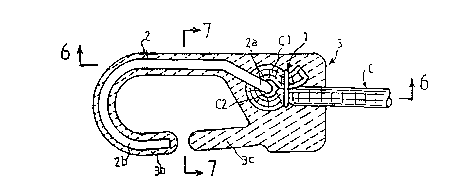Some of the information on this Web page has been provided by external sources. The Government of Canada is not responsible for the accuracy, reliability or currency of the information supplied by external sources. Users wishing to rely upon this information should consult directly with the source of the information. Content provided by external sources is not subject to official languages, privacy and accessibility requirements.
Any discrepancies in the text and image of the Claims and Abstract are due to differing posting times. Text of the Claims and Abstract are posted:
| (12) Patent: | (11) CA 2174044 |
|---|---|
| (54) English Title: | ATTACHMENT AND CABLE FASTENING DEVICE |
| (54) French Title: | ATTACHE ET DISPOSITIF DE FIXATION DE CABLE |
| Status: | Expired and beyond the Period of Reversal |
| (51) International Patent Classification (IPC): |
|
|---|---|
| (72) Inventors : |
|
| (73) Owners : |
|
| (71) Applicants : |
|
| (74) Agent: | MACRAE & CO. |
| (74) Associate agent: | |
| (45) Issued: | 2000-04-11 |
| (22) Filed Date: | 1996-04-12 |
| (41) Open to Public Inspection: | 1996-10-14 |
| Examination requested: | 1997-07-21 |
| Availability of licence: | N/A |
| Dedicated to the Public: | N/A |
| (25) Language of filing: | English |
| Patent Cooperation Treaty (PCT): | No |
|---|
| (30) Application Priority Data: | ||||||
|---|---|---|---|---|---|---|
|
An attachment and cable fastening device. The device
has an elongate elastic cable folded over at least one of
its ends to form an eyelet. An metallic ring is crimped
around the elastic cable's folded over ends. A strong metal
hook with a frontwardly lying generally U-shaped front hook
portion and a bent end extremity is placed with its bent end
extremity fitted into the eyelet. A plastic covering is
formed around the folded over end of said elastic cable, the
metallic ring and the strong metal hook.
Note: Claims are shown in the official language in which they were submitted.
Note: Descriptions are shown in the official language in which they were submitted.

2024-08-01:As part of the Next Generation Patents (NGP) transition, the Canadian Patents Database (CPD) now contains a more detailed Event History, which replicates the Event Log of our new back-office solution.
Please note that "Inactive:" events refers to events no longer in use in our new back-office solution.
For a clearer understanding of the status of the application/patent presented on this page, the site Disclaimer , as well as the definitions for Patent , Event History , Maintenance Fee and Payment History should be consulted.
| Description | Date |
|---|---|
| Inactive: IPC from MCD | 2006-03-12 |
| Time Limit for Reversal Expired | 2002-04-12 |
| Letter Sent | 2001-04-12 |
| Inactive: Late MF processed | 2000-04-26 |
| Grant by Issuance | 2000-04-11 |
| Inactive: Cover page published | 2000-04-10 |
| Inactive: Final fee received | 2000-01-12 |
| Pre-grant | 2000-01-12 |
| Notice of Allowance is Issued | 1999-12-13 |
| Notice of Allowance is Issued | 1999-12-13 |
| Letter Sent | 1999-12-13 |
| Inactive: Approved for allowance (AFA) | 1999-11-18 |
| Inactive: Entity size changed | 1998-04-28 |
| Letter Sent | 1997-10-08 |
| Inactive: Application prosecuted on TS as of Log entry date | 1997-10-02 |
| Inactive: Status info is complete as of Log entry date | 1997-10-02 |
| All Requirements for Examination Determined Compliant | 1997-07-21 |
| Request for Examination Requirements Determined Compliant | 1997-07-21 |
| Application Published (Open to Public Inspection) | 1996-10-14 |
There is no abandonment history.
The last payment was received on 1999-04-08
Note : If the full payment has not been received on or before the date indicated, a further fee may be required which may be one of the following
Please refer to the CIPO Patent Fees web page to see all current fee amounts.
| Fee Type | Anniversary Year | Due Date | Paid Date |
|---|---|---|---|
| Request for examination - standard | 1997-07-21 | ||
| MF (application, 2nd anniv.) - small | 02 | 1998-04-14 | 1998-04-14 |
| MF (application, 3rd anniv.) - small | 03 | 1999-04-12 | 1999-04-08 |
| Final fee - small | 2000-01-12 | ||
| Reversal of deemed expiry | 2000-04-12 | 2000-04-26 | |
| MF (patent, 4th anniv.) - small | 2000-04-12 | 2000-04-26 |
Note: Records showing the ownership history in alphabetical order.
| Current Owners on Record |
|---|
| ANTOINE DE ANFRASIO |
| Past Owners on Record |
|---|
| None |